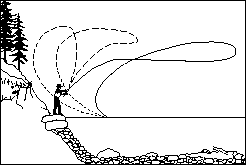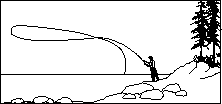 THE
ART & SCIENCE OF SPEYFISHING THE
ART & SCIENCE OF SPEYFISHING
by
Mike Maxwell
"Spey
casting is making a comeback in North America, thanks to the
development of a true spey rod and the dedication of people
like Mike Maxwell."
-Atlantic
Salmon Journal,
Summer 1990, Vol. XXXIX,
No. Two
A
BETTER WAY
How many times have you fished your favourite river, knowing
the fish were there, but found it impossible to cast without
hooking the bushes behind you or sticking yourself with your
fly.
Many anglers faced with this annoying situation will try to
wade out farther, often into dangerous currents, to provide
backcasting room. Frequently they end up disturbing the fish
they are attempting to hook. Others will false cast parallel
to the bank before attempting to swing the line out into the
river, while some will make a fish disturbing roll cast to the
target area. These emergency measures force the fisherman to
make the only cast possible instead of the presentation they
intended.
These frustrating and sometimes dangerous conditions frequently
result in the angler muttering to himself that there just has
to be a better way. There is a better way, one that is as old
as the hills and used with great success throughout Europe.
However, for some inexplicable reason, the technique seems to
have taken a long time to cross the Atlantic to North America.
The
better way, of course, is fishing with a long, double-handed
speyrod or salmon rod, as our European readers call it. Once
you understand the full advantages of this method of angling,
you will without doubt ask yourself: can it be learned and is
the equipment available.

Fishing
with a double-handed speyrod allows you to make any presentation
you choose, at any angle, from downstream to upstream, with
dry or wet fly, in high or low water, and in all but gale force
wind and without dangerous wading.
Furthermore,
all this is possible without the fly every going behind you
or coming near you. And, with a long, limber speyrod in your
hands, you'll have the ability to make perfect aerial and water
mends, you'll lose fewer fish using smaller flies, due to the
shock absorbing characteristics inherent in the rod, and you'll
enjoy an unbeatable method of angling.

To
illustrate the main advantages of the speyrod, consider the
sketch which shows a typical river scene. The overhead caster
is located on the gravel side of the stream, to make room for
his back cast, and he is casting to the fish on the other side
of the river. He is wading deep, has virtually no control over
the fly, and wastes time retrieving line, false casting and
replacing broken flies. However, the enlightened speycaster,
who is closer to the fish, stands pretty well out of the water,
covers the fish without him or his fly ever being in danger,
returns the fly to the water immediately after each swing, without
false casting and then controls the line and the fly perfectly.
He usually fishes alone, covering undisturbed fish with about
twice the effective fishing time. Who is going to be more successful?
|



 THE
ART & SCIENCE OF SPEYFISHING
THE
ART & SCIENCE OF SPEYFISHING
